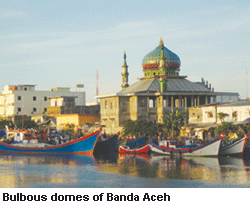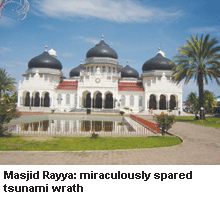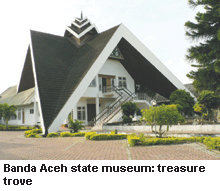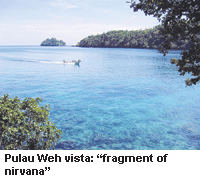A decade-long secessionist war in the Aceh region had led to tens of thousands of deaths and many more forcibly displaced from their homes. Aceh had also suffered a toll of some 80,000 in the deadly tsunami of 2004. Yoginder Sikand recounts his passage to the northern apogee of Sumatra
 As recounted in my last dispatch (October) to these pages, I had been in Sumatra, the largest of Indonesia’s 17,000-plus islands for three weeks, unwinding in mountain resorts, trekking up extinct volcanoes and spending a blissful fortnight on the tropical island paradise of Pulau Samosir and the resort of Tuk-Tuk in particular. But yet, a wider world was waiting to be explored in this exotic island, the eighth largest in the world. I wanted to visit the oil-rich province of Aceh way up north in Sumatra.
As recounted in my last dispatch (October) to these pages, I had been in Sumatra, the largest of Indonesia’s 17,000-plus islands for three weeks, unwinding in mountain resorts, trekking up extinct volcanoes and spending a blissful fortnight on the tropical island paradise of Pulau Samosir and the resort of Tuk-Tuk in particular. But yet, a wider world was waiting to be explored in this exotic island, the eighth largest in the world. I wanted to visit the oil-rich province of Aceh way up north in Sumatra.
A decade-long secessionist war in the Aceh region had led to tens of thousands of deaths, and to many more people being forcibly displaced from their homes. Acehnese independence fighters, claiming sovereignity and smarting under what they regarded as pervasive discrimination at the hands of the Javanese-dominated Indonesian state, were still active in some parts. Aceh had also suffered a toll of some 80,000 people in the deadly tsunami that struck in 2004, totally devastating large tracts along the coast. The province has been granted enhanced autonomy, in particular being allowed to impose Islamic law in some matters, one of the principal demands of the separatists. Regrettably the Acehnese regard themselves as among the most militantly Islamic of Indonesia’s numerous ethnic communities.
I boarded an overnight bus at Medan, Sumatra’s largest city, for Banda Aceh, the capital of Aceh province, a journey of 15 hours. Around midnight, the bus stopped for dinner. Just then, I discovered I had run out of Indonesian currency, having forgotten to purchase local rupiahs at Medan. Yet a matronly proprietor of a café insisted I should dine even after I had explained my impecunious status to her. She piled my plate with rice, coconut curry, fried peanuts, vegetables, and a bowl of hot noodle soup. Since I had no money to defray the cost of dinner, I gifted her an Indian shawl which she accepted after much persuasion.
After dinner, the bus plunged ahead into the moonlit darkness, racing through tiny villages and occasional towns, in one of which I spotted a Sikh gurdwara, its dome glistening in the soft moonlight. Despite the late hour, shops were open, most of them run by women, their heads demurely wrapped in Islamic headscarves, now compulsory as per the diktat of the provincial government which rules according to the Islamic shariah. As a flicker of pale orange light began lighting up the far horizon, and swathes of paddy fields and palm estates interspersed with neat cottages and mosques with bulbous domes hove into view, I discovered I was in Banda Aceh (pop. 260,000).
With great difficulty and after considerable haggling, I managed to secure a room in a shabby lodge that cheekily announced itself as Your Second Home. Almost everything in Aceh is more expensive than the rest of Sumatra, because of the enormous distance involved in transporting goods to this remote part of the island, and also because the influx of hundreds of foreign-funded NGO professionals into the area following the killer tsunami had pushed up prices. For a shoddy, windowless hotel room with stained cardboard walls, I paid the price of a four-star hotel room elsewhere, including Tuk-Tuk.
After freshening up, I reconnoitered the town, which is small enough to explore on foot and has a dose of colonial history. The Europeans initially came here as adventurers, and later as traders and colonists. The Dutch quarter, which housed colonial administrators and businessmen when Aceh was a major trading post of the Dutch East Indies, straddles a river, its grand colonial edifices now converted into government offices and shopping centres. Gaily-painted country boats were docked at a wharf leading to the sea which looked deceptively calm. But five years ago giant waves had come crashing in from these calm waters, as Asia’s most lethal natural disaster laid waste to almost the whole town of Banda Aceh.
 The soaring three-domed masjid Rayya or Central Mosque, which according to its notice board is built in “typical Indian style” was miraculously spared the wrath of the tsunami. Today it stands in pearl-white majesty on a vast plain on the far side of the river. Inside its colonnaded, marble-floored hall, a marriage had just concluded. Cameras vigorously clicked an over-dressed bride and her groom who wore the traditional batik sarong, a long shirt, a brocade sash around his waist, and a black felt cap on his head. Groups of small boys and girls swayed as they recited verses from the Quran placed on carved stands before them, with their teachers keeping close watch. To my pleasant surprise, some of those teachers were women, as were the staff who swept the mosque. Such division of labour would be unthinkable in India. In contrast with India and much of the Muslim world, women freely pray in mosques here, because the Shafi school of Islamic jurisprudence followed by most Indonesians permits women greater workplace and other freedoms.
The soaring three-domed masjid Rayya or Central Mosque, which according to its notice board is built in “typical Indian style” was miraculously spared the wrath of the tsunami. Today it stands in pearl-white majesty on a vast plain on the far side of the river. Inside its colonnaded, marble-floored hall, a marriage had just concluded. Cameras vigorously clicked an over-dressed bride and her groom who wore the traditional batik sarong, a long shirt, a brocade sash around his waist, and a black felt cap on his head. Groups of small boys and girls swayed as they recited verses from the Quran placed on carved stands before them, with their teachers keeping close watch. To my pleasant surprise, some of those teachers were women, as were the staff who swept the mosque. Such division of labour would be unthinkable in India. In contrast with India and much of the Muslim world, women freely pray in mosques here, because the Shafi school of Islamic jurisprudence followed by most Indonesians permits women greater workplace and other freedoms.
I stepped out into the bazaar for a street-level experience. The market was buzzing with activity. On the pavements, hawkers, mainly women, displayed their produce: baskets with scoops of fresh mushrooms, fruit and vegetables from the Aceh highlands, orchids and bonsai in porcelain pots, dozens of fish varieties. Chinese shop-keepers, who constitute a tiny proportion of the town’s population but who, as in much of Indonesia, control most of its trade, sat in well-appointed shops and showrooms.
Once there had been numerous Indian-owned shops in Banda Aceh, run by Tamils, Sindhis and Punjabis. Some of them had perished in the tsunami of 2004; the rest had fled to interior Sumatra, never to return. A sole Tamilian named Radhakirshna remained, a third-generation Sumatran who spoke only Acehnese and didn’t know a word of the language of his ancestors. He had lost his four children and wife in the tsunami, and survived as a motor mechanic, his tin-shed shop sited adjacent to the rubble of Aceh’s only Hindu temple, destroyed by the tsunami.
A toothless old man strode up to me. “Orang India?” he asked. Was I an Indian, he wanted to know, to which I nodded. And then, as I experienced innumerable times in Sumatra, he popped the inevitable questions: was I related to movie star Amitabh Bacchan; had I ever met Shah Rukh Khan; did I live in the same town as Aishwarya Rai? Bollywood films are the rage in Indonesia, and in much of South-east Asia, and are often the only source of information about India. I heard a Hindi film song playing in a nearby shop. The excited man hollered out to his friends and they drew up to me, giggling and staring as if I were some sort of quaint zoological exhibit. “Kuch kuch hota hai”, warbled one of them, laughing as he imitated a Bollywood actor, and gyrating like a top, thrust out his hips and chest, much to the mirth of onlookers.
 I spent an entire day at Banda Aceh’s state museum. Housed in a handsome Dutch colonial mansion, it is a treasure trove of history and ethnography, illustrating the waves of cultural influences that together have woven the unique Acehnese identity, which the people of the province (who insist they are distinct from the rest of Indonesia) jealously guard. The museum features 11th century inscriptions in the Tamil language carved on massive slabs of stone, a legacy of the Chola emperors of South India who had ruled this part of Sumatra.
I spent an entire day at Banda Aceh’s state museum. Housed in a handsome Dutch colonial mansion, it is a treasure trove of history and ethnography, illustrating the waves of cultural influences that together have woven the unique Acehnese identity, which the people of the province (who insist they are distinct from the rest of Indonesia) jealously guard. The museum features 11th century inscriptions in the Tamil language carved on massive slabs of stone, a legacy of the Chola emperors of South India who had ruled this part of Sumatra.
Other antiquities include tomes written in neatly calligraphed Arabic on palm-leaf paper, richly embellished copies of the Quran and works on Islamic mysticism, jurisprudence and theology. Letters, in the form of enormous scrolls, penned by successive Sultans of Aceh to the rulers of England and Portugal discussing trade and commerce are also on display. Others were on the economics of the lucrative spice trade and the menace of pirates, one of them addressed to the Ottoman Sultan in Istanbul, appealing for military assistance against Dutch marauders.
Also exhibited is a montage of tribal-style weapons, robes, and head-dresses from the period when animistic traditions prevailed in Aceh before the region was almost wholly Islamised. There are intriguing photographs of Dutch colonial officers, wearing coats and hats in the tropical sun, surrounded by native servants or seated imperiously on caparisoned elephants. In the courtyard of the museum are rows of Chinese-style tombs, shaped like pagodas, of successive Muslim rulers of Aceh and neighbouring kingdoms.
Although the tsunami of 2004 destroyed some 70 percent of its buildings, the town has been almost completely reconstructed and seemed distinctly more organised and cheerful than other places in Sumatra. Yet the horror of the catastrophe has deeply impacted its citizens. The dead are commemorated by a huge tsunami memorial built in the shape of a massive ship sited contig-uous to a real ship, more than 100 metres long, which was heaved up by the killer waves and deposited 3 km inland, where it now sits like a giant beached whale.
 From Banda Aceh I took a ferry to the island of Pulau Weh, 25 km into the Andaman Sea, accurately described in tourist brochures as one of Indonesia’s most inviting island resorts. Famed for its magnificent corals and palm-fringed beaches, set in a placid turquoise sea, this is a fragment of nirvana, if ever there was one.
From Banda Aceh I took a ferry to the island of Pulau Weh, 25 km into the Andaman Sea, accurately described in tourist brochures as one of Indonesia’s most inviting island resorts. Famed for its magnificent corals and palm-fringed beaches, set in a placid turquoise sea, this is a fragment of nirvana, if ever there was one.
The ferry deposited us at Sabang, less than an hour later, a major settlement on Pulau Weh, Indonesia’s northern-most outpost, just a day’s sea journey from India’s Nicobar islands. I hitched a ride to Iboih, the village where I planned to stay, on a bejak — a cross between a motorcycle and an Indian auto-rickshaw, passing through acres of forest and hills, verdant paddy fields, banana, mango and cocoa groves and silent villages. Iboih was as I had imagined it. Although it comprised only a few shacks that served as shops and eateries, and a dozen log huts which served as inns built on a precipice, Iboih offered a serene, uninterrupted vista of the vast Indian Ocean.
The three days I spent in Iboih are a cherished memory of undisturbed bliss. I swam in the aquamarine waters, relaxed on the spotless powder sands that stretched to the end of the island, and explored neigh-bouring villages, sampling local delicacies. These indulgences apart, the highpoint of my stay was the last evening when I met Nasir, a local fisherman, who agreed to take me on his glass-bottomed boat to Rubiah island, 20 metres offshore.
.gif) When he lifted the board covering the bottom of the boat, an entirely different world appeared before my awestruck eyes: the surreal subterranean depths of Pulau Weh. Thirty metres below the still sea was a splendid vista of coloured corals, some erotically shaped, others like pin-cushions and quaint vegetables, through which dozens of brilliantly-hued tropical fish and sharks darted about.
When he lifted the board covering the bottom of the boat, an entirely different world appeared before my awestruck eyes: the surreal subterranean depths of Pulau Weh. Thirty metres below the still sea was a splendid vista of coloured corals, some erotically shaped, others like pin-cushions and quaint vegetables, through which dozens of brilliantly-hued tropical fish and sharks darted about.
I had been in Sumatra for almost a month and it was time to return to Malaysia, and from there to head back home to India. The sea voyage back was a contrasting nightmare. The boat to Penang, across the Andaman Sea, almost drowned in a violent storm. It was the most turbulent crossing I’ve ever experienced, and I swore to myself I’d never undertake a sea journey again. Except, perhaps back to Aceh.